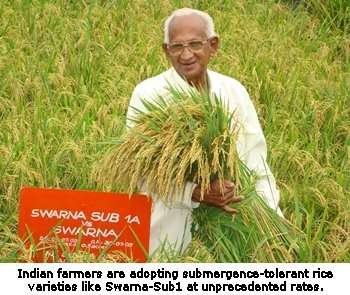For
quite some time, the human race has longed to create crops that are
adaptable to any type of weather, mainly floods. This would benefit us
in many ways, since we lose so many crops due to field flooding. If
our crops could survive through floods, then there would be less of an
economic impact in the affected area, as well as a steady food supply in
the surrounding communities.
1986-1988:
A large sample size of 2,000 wheat lines was planted and grown in Japan by the National Agricultural Research Center for Western Region. Out of those two-thousand wheat lines, only ten were declared water-logging (flood) tolerant. These ten wheat lines were from Nepal, Paraguay, Tohoku in Japan, Italy, and Yugoslavia.10
Also in 1988:
Chinese Spring, a commonly used wheat in experiments, was tested for its tolerance. One wheat was grown in a pot with a drainage hole to represent a dry crop. Then a wheat plant was grown in a pot with the drainage hole plugged. Then at the one leaf stage, the wheat with the plugged hole was flooded. This plant was then grown like this until harvest time. The flooded plant showed no difference in height and stature, but its grains shriveled and decreased in weight. However the plant remained fertile and could therefore reproduce.10
January 29, 2009:
Fighting Hunger with Flood Tolerant Rice:
Rice is usually grown in flooded fields, so the weeds aren't able to grow, even though most rice plants aren't adapted to being underneath water for such a long time. Normal rice plants can hardly survive 3 days underneath the flood water, but the Sub1 gene allowed normal rice, to be under the flood waters for up to 17 days. The conventional bred rice wasn't accepted by the farmers, due to odd taste. Three years later, they reintroduced the Sub1 gene using precision breeding. The rice was exactly the same, they could normally harvest, plant and the rice tasted the same too. Bangladesh and India is where the test fields were, and extra rice was produced, so families could sell it and have more money. Scientists say that within two years, flood-tolerant rice should be available in India and Bangladesh. 3
October 23rd, 2011:
BREAKTHROUGH;
Scientists discover the molecular mechanism that allows some plants to be flood tolerant. It is essentially "scuba gear for plants". This spikes more interest in the field.4
1986-1988:
A large sample size of 2,000 wheat lines was planted and grown in Japan by the National Agricultural Research Center for Western Region. Out of those two-thousand wheat lines, only ten were declared water-logging (flood) tolerant. These ten wheat lines were from Nepal, Paraguay, Tohoku in Japan, Italy, and Yugoslavia.10
Also in 1988:
Chinese Spring, a commonly used wheat in experiments, was tested for its tolerance. One wheat was grown in a pot with a drainage hole to represent a dry crop. Then a wheat plant was grown in a pot with the drainage hole plugged. Then at the one leaf stage, the wheat with the plugged hole was flooded. This plant was then grown like this until harvest time. The flooded plant showed no difference in height and stature, but its grains shriveled and decreased in weight. However the plant remained fertile and could therefore reproduce.10
January 29, 2009:
Fighting Hunger with Flood Tolerant Rice:
Rice is usually grown in flooded fields, so the weeds aren't able to grow, even though most rice plants aren't adapted to being underneath water for such a long time. Normal rice plants can hardly survive 3 days underneath the flood water, but the Sub1 gene allowed normal rice, to be under the flood waters for up to 17 days. The conventional bred rice wasn't accepted by the farmers, due to odd taste. Three years later, they reintroduced the Sub1 gene using precision breeding. The rice was exactly the same, they could normally harvest, plant and the rice tasted the same too. Bangladesh and India is where the test fields were, and extra rice was produced, so families could sell it and have more money. Scientists say that within two years, flood-tolerant rice should be available in India and Bangladesh. 3
October 23rd, 2011:
BREAKTHROUGH;
Scientists discover the molecular mechanism that allows some plants to be flood tolerant. It is essentially "scuba gear for plants". This spikes more interest in the field.4
This video exhibits how rice with the Sub1 gene lasts longer and grows better than normal rice. Also notice, that the Sub1 gene crop(on the left) grows better and lasts longer in the flooded fields. |  |